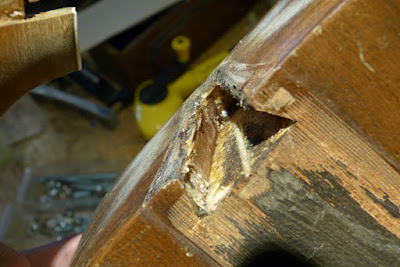Workshop: Shim Shim Shim
Lots was done, today! Three neck resets, three bridge reglues, seam repairs -- all sorts of stuff. Here's a shot of one of these patients (an x-braced Regal 000 all-mahogany guitar from the 30s) during surgery.
One of the most frustrating things about doing neck resets on old Chicago guitars is a neck that's obviously loose in the joint but won't budge. Usually I can just tap the heel of a neck on a Harmony, Regal, or Kay after all these years and it'll pop right off (an example of relying on glue to hold the neck in place rather than making a tight joint). When they won't come off like that I know the reason and it means I have to steam the neck out to loosen it up further.
Do you see it? There's a mahogany shim on the bass side of that dovetail joint.
There's also another one over here.
When this neck was "reset" at some point in the past (note the broken end of the dovetail on the heel), it was shimmed-up and reglued. The problem is that most of the time the dovetails aren't cut very well in the first place, so simply jamming some shims in and gluing-up doesn't often solve the problem of bad back-angle on the neck or the problem of keeping the bottom part of the heel snug in the joint.
Do do a "shim job" correctly you really have to work on it, tapering the shims to fit the lower bit of the dovetail and then making sure that the shims at the top of the heel are supplying the proper back-angle and support to keep the neck from pitching forward over time. When I do a shim-style reglue/reset, I make the joint mechanically stable without glue before gluing, and that "check" tends to keep it all pat as the guitar ages.
Also? You can always glue it up and then bolt the neck, too! I've been doing that on less-expensive guitars, lately, as it's a little extra insurance should the material in the neck pocket shift during clamping of the joint -- or if someone is careless and leaves it in a hot car and the glue wants to creep. Bad dovetails are a serious design flaw and the fact that bolted necks are becoming very popular on modern and less expensive guitars is proof of the industry's acknowledgement of that.



Comments